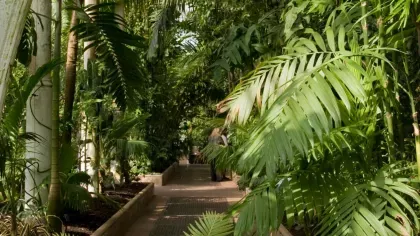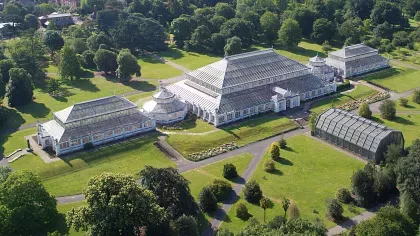31 July 2015
Medicinal knowledge in the Amazon
As the Yanomami of Brazil publish their traditional medicinal knowledge for the first time, in collaboration with Kew, William Milliken explores the transfer of traditional knowledge both within and outside traditional communities.

In May this year Hutukara, the Yanomami indigenous association in the northern Brazilian Amazon, published a book on their traditional medicines, in their own language, for the first time (Yanomami et al. 2015). The data, including 101 species of plants, six fungi and 14 insects, were collected by indigenous researchers in a single village – Watoriki – between 2012 and 2013. Its publication, the fruit of a collaborative project involving Kew, Instituto Socioambiental and Institut de Recherche pour le Développement, builds on a legacy of research stretching back twenty years.
To publish or not to publish
In the early 1990s, working with the French anthropologist Bruce Albert, I spent several months in the same Yanomami village researching traditional medicine. Much of the information was published in scientific articles (Milliken & Albert, 1996, 1997; Albert & Milliken, 2010), but a substantial body was withheld. Whilst many of the plant uses recorded among the Yanomami mirrored those published from other Amazonian indigenous groups, we were uncomfortable putting ‘new’ medicinal uses into the public domain without full consultation of the Yanomami, and at the time that wasn’t an option. At the turn of the Millennium, when we finally decided the time was right to publish a manual, sudden and radical changes in Brazilian legislation forced a decision to put this on hold until the political climate became more clement.
In the intervening period a number of things changed. Firstly, the Brazilian Yanomami established an association capable of representing their opinions collectively, and of developing initiatives across their territory. Secondly, education programmes established a cadre of literate young Yanomami, many of whom had no obvious means of applying their literacy skills within their communities. Meanwhile the last two members of the Watoriki community who held substantial knowledge of traditional medicine had become substantially older, yet still very little of that knowledge had made its way through to younger generations.
Disappearing knowledge
These two men – Justino and Antonio – are to some degree anomalous. Our studies have showed that whereas shamanism is primarily the domain of men among the Yanomami, healing with plants is, traditionally, primarily the domain of women. Justino described the reason in an interview held during the field research, and which was included in an introductory section of the book:
“It was on the Rio Werihisipi u that it really finished, after more people died in epidemics… Only one of the old woman survived: Antonio’s mother. Only she survived to treat us – just her alone! She treated, treated… When the evil spirit Riori attacked someone she looked for riori wexikɨ mushrooms, and for kurapoma kohi resin to mix it with. That’s how it was. But it was here in Demini that we were finally properly impoverished. After the fear we suffered following her death, these cures stopped completely here. This really happened: she was the only surviving person who treated us, and after her death this finished.”
“That’s how it happened. We old ones still know because we watched our mothers use these medicines over time, and that’s why we’re teaching it now. Only the two of us are left, Antonio and I. Just two men. Our mothers collected these leaves and I thought “Aha! These are the ones they use to cure”. Isn’t that how people get things from their mothers? While I stayed squatting down saying nothing, I saw her treating people, giving them baths, pressing them to their calves when they hurt. Thus, after I’d seen her doing this, I watched closely and that’s why I still know these cures and can teach them. Here the people are growing up without learning; there aren’t any old people left here. The mothers of the young people here already didn’t know anything because their own mothers – their grandmothers – didn’t live to teach them. That’s how they ended up not knowing.”
Community research and knowledge transmission
The driving force behind the project was Morzaniel Yanomami, who saw it as an opportunity to capture disappearing knowledge for the future whilst strengthening capacity for autonomous research among communities. It sits within a broader programme (Saberes da Floresta Yanomami) that’s working to value, strengthen and disseminate Yanomami knowledge and language. As scientists, our role in the project as was primarily one of facilitation. We helped the Yanomami researchers to develop a methodology, provided training, accompanied them in the field and generally supported the data collection, organisation and publication process. Most of the species had already been identified at Kew during the earlier research, and were represented by collections in the Herbarium. This meant that the project could, in this instance, be undertaken without the need for taking specimens out of the area.
Whilst the systematic collection and publication of their traditional medicinal knowledge offers obvious potential benefits for future generations of Yanomami, the pressing priority is to maintain it as living knowledge and practice in the context of increasing levels of exposure to, and pressures from, the outside world. When one of the young researchers at Watoriki pointed out that she hadn’t previously known about medicinal plants because her mother hadn’t taught her, Justino’s response was “well we’ve been here all the time but nobody asked us”. This may be partly due to gender issues: this was effectively ‘female knowledge’, and mechanisms for its transfer between genders are limited within Yanomami society. The involvement of several young women in the research process may to some extent have helped to shift the knowledge back into the domain within which it originally lay.
In the course of the new research a few species and uses were added to our list from the 1990s, and a few were removed. The additions were partly the result of knowledge exchange with other communities during the intervening period, reflecting the dynamic nature of traditional medicine systems, and partly to the participation of two older women who had not been involved in the original research. The removals were mainly due to absence of a man who, in the 1990s, had been visiting from another community (Toototobi) and contributed some of his knowledge to our data.
Publishing traditional knowledge
Publishing this work raised a number of tricky questions which needed to be answered by the Yanomami themselves. One was whether or not to make the book bilingual – to include Portuguese alongside Yanomami – and the other was whether to incorporate scientific names. Given that the primary aim was to develop a resource for themselves, neither was obviously essential. However, there are underlying questions around the risks and benefits making medicinal knowledge available in the public domain. On one hand this allows knowledge-holders to ‘stake a claim’ on their knowledge and, by incorporating scientific names, to make the connection with species unambiguous.
This may not only help to secure future revenue from drug development, though the likelihood of this is low, but also to increase their capacity to benefit from the wealth of existing scientific knowledge surrounding many of those species. On the other hand, some argue that publication makes the knowledge available for unscrupulous exploitation. This dichotomy has been a matter of great debate over recent years, and the tide appears to be shifting in the direction of disclosure. A number of other indigenous peoples are now publishing their traditional medicine in accessible languages including, recently, the Matsés. The Traditional Knowledge Digital Library (TKDL) initiative in India has taken this a step further by systematically making knowledge available in a deliberate attempt to combat biopiracy.
The shifting sands of regulation and legislation
The publication of this book coincides with an interesting moment in Brazilian regulations around genetic patrimony and traditional knowledge. Following the introduction of the ‘Medida Provisoria’ regulations in 2001, research in this area became been extremely – sometimes prohibitively – complex. This generated substantial, ongoing debate in Brazil over the extent to which it stifled science (Corrêa de Melo 2015). Indeed, the situation with regards to research and publication, even by indigenous researchers working in their own lands with their own traditional knowledge, was so complex that it was judged necessary for Hutukara to approach CGEN, the government body tasked with controlling access to ‘genetic patrimony and associated knowledge, to ensure that no laws were being transgressed by the Yanomami. On the 20th of May this year the President of Brazil, Dilma Rousseff, sanctioned a new law (Marco Legal de Biodiversidade) designed to simplify access and promote scientific and economic development of the country’s biodiversity. Its impact on science and on equitable benefit sharing remains to be seen.
The way forward
We know from our wider research that the medicinal plants and animals from Watoriki published in this book represent only part of a much larger body of Yanomami medicinal plant knowledge. In the future we plan to extend the programme to other communities, drawing on our experience from the project. To expect a sudden blossoming of autonomous research among the Yanomami would be unrealistic, and it was clear from our experience that this is a flower that needs to be carefully nurtured and supported. However, it is equally clear that there is a great deal to be gained, both by scientific and traditional communities, from collaborative efforts that build capacity for indigenous research and redress the historical imbalance between their spheres of knowledge and expertise.
References
Albert, B. & Milliken, W. (2010). Urihi A – A terra-Floresta Yanomami. Instituto Socioambiental/ Institut de Recherche pour le Développement, São Paulo.
Corrêa de Melo, S. S. (2015). A Medida Provisória nº 2.186/2001 e a pesquisa com a biodiversidade brasileira. Available online
Milliken, W. & Albert, B. (1997). The use of medicinal plants by the Yanomami Indians of Brazil II. Economic Botany 51(3): 264-278. Available online
Milliken, W. & Albert, B. (1996). The use of medicinal plants by the Yanomami Indians of Brazil. Economic Botany 50(1): 10-25. Available online
Yanomami, M. I., Yanomami, E., Albert, B., Milliken, W. & Coelho, V. (2014). Hwërɨ mamotima thëpë ã oni. Manual dos remedios tradicionais Yanomami. Hutukara/Instituto Socioambiental, São Paulo.



